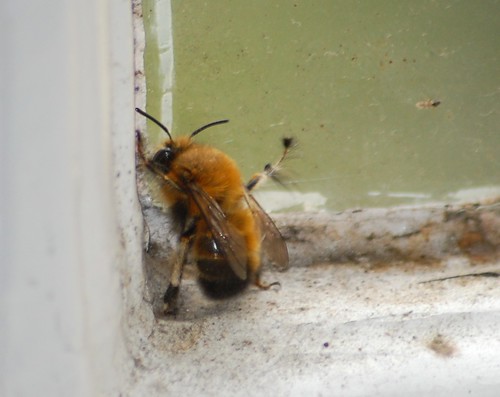I've had a productive couple
of weeks for wildlife-spotting - spring is properly here and the insects in
particular are responding to the change.
As the buds burst and flowers
begin to appear, insects too are emerging from their winter dormancy. The new
leaves are covered with leafhoppers and caterpillars, and the flowers with
pollen beetles and bees.
If you go by the media
reports you might be forgiven for thinking there's just one British bee, the
honeybee Apis mellifera. In fact, it's a bit more complicated than that - we
have 1 honeybee, 25(ish) bumblebees and 230-250 species of solitary bees.
Various bumbles and the honeybee visit my garden, but I'm lucky enough to have
some of the solitaries call it home. In particular two species live in the back
wall of my house. One of the signs of early spring is the colony of
Hairy-footed flower bees (Anthophora plumipes) waking up, darting at high speed
between flowers and zipping in and out of the holes in the wall. Zipping is
really the word too - electrifyingly fast, the males in particular seem to move
flower to flower without occupying the intervening space.
 |
| A male Hairy-footed flower bee, Anthophora plumipes |
The best indicator of the
changing seasons though is the moth trap in my back garden. A 125-Watt
mercury-vapour bulb perched on top of a box of moth bedding (aka egg boxes), it
attracts in a sample of the moths flying past, ready to be identified and
released the following morning. You never get the same mix of species and
individuals twice running, so it's a great way to measure the changing of the
seasons.
 |
| The moth trap, doing its thing in the back garden |
I started trapping for the
year in early March, catching small numbers of the early-spring species.
Gradually as the year wore on, the numbers got bigger (60 moths of 11 species on the 2nd April the
best to date) and the species changed - Orthosia (Quakers and the Hebrew Character) began to dominate, Common
Quaker in particular. In the last week what I think of as the 'late spring'
species have begun to appear - the furry Muslin moth (Diaphora mendica) and an early Bee moth (Aphomia sociella) -
reinforcing that the world is moving forwards, and summer is shimmering on the
horizon...
No comments:
Post a Comment